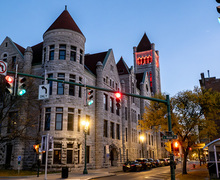ESF : Bug bites: Termites inspire invention of robots that allow for harnessing of wind energy
Little semi-automatic robots are allowing buildings to harness a new type of wind energy and could be the future of architecture. The inspiration came from termite mound research by J. Scott Turner.
Turner, a professor at the State University of New York College of Environmental Science and Forestry, is leading a team of international researchers who have received a $1.3 million grant to study the function of termite mounds in Africa, according to a March 30 ESF press release. The mounds are thin, tan cones standing as high as 9 feet.
‘Our research is opening up some new horizons for how we can exploit wind energy to control climates within buildings,’ Turner said. ‘Termites are vital for their habitats, and they may be telling us something valuable about how we can build our own buildings.’
There are two types of wind energy, Turner said, and termite mounds in Africa tap into a form of wind energy that humans have not yet been able to capture. People are only able to access wind energy from steady breezes, which can be troublesome because it requires tall turbines and buildings that are expensive and unreliable.
To circulate gases and regulate temperatures through a colony that lives deep underground, termites have found a way to access turbulent wind energy. Engineers and architects have struggled to capture this sort of energy for years.
Turner said he found that an incorrect explanation of the mound’s inner workings has previously been accepted. This is hampering architects’ attempts in trying to imitate the mounds to build structures with more efficient heating and cooling systems.
‘One of the big challenges was sorting through what everyone thought was a well-established principle that turned out to be almost entirely incorrect,’ Turner said.
Lisa Margonelli, an award-winning author and journalist who has been reporting on Turner’s research since 2008, said Turner disproved an old theory that the mounds act primarily as chimneys allowing extra heat to escape from underground.
‘Turner discovered in fact what is going on in the mounds is much more complicated,’ Margonelli said.
Margonelli said Turner conducted his research by using computers to both observe the termites more closely and mimic the termites’ behavior as they build their mounds.
Turner takes time-lapse pictures of the colony’s behavior overnight. He then codes the termites’ activity into a computer and, with programmers, builds computer models so the codes behave like actual termites.
Turner said he hopes these robotic termites may be used someday to construct and sustain buildings for people. The robotic insects would allow these buildings to use their unique system of efficient heating and cooling that starts within the mounds.
He discovered, unlike previous theories, very few termites actually live in the mounds. They are primarily an organ, similar to a lung, which circulates oxygen in and carbon dioxide out of where the termite colony lives. This process is vital for the colony, which, on average, consists of more than a million termites that consume oxygen at the same rate as a cow, and is powered by turbulent wind energy.
But being able to transfer the termites’ system into actual architecture designs and robotic models takes much more research. This is why Turner said he and his team are thankful for the grant from the Human Frontier Science Program. It will allow them to carry out advanced field and lab research in India, the United States and Namibia, according to the ESF press release.
‘We have an interesting interdisciplinary team,’ Turner said.
His team includes an insect swarms expert from India, an engineering and robotics expert from the University of Greenwich in England, a scientist who studies fluid mechanics and robotics at Harvard University, and an ecologist from Namibia who studies the natural history of termites, according to the release.
‘We’ve got a lot of people who are really interested in this problem and are ready to get to work,’ Turner said. ‘We are hoping some more interesting, creative ideas will come out of it.’
Published on April 8, 2012 at 12:00 pm
Contact Shannon: smhazlit@syr.edu





